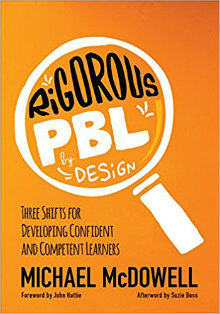Three PBL Shifts Can Add Rigor & Clarity
Rigorous PBL by Design: Three Shifts for Developing Confident and Competent Learners
By Michael McDowell
(Corwin, 2017 – Learn more)

As a middle school teacher who has used Project Based Learning (PBL) for the past few years in my classroom, I found this book to be incredibly helpful. However, if I had stumbled upon this book without ever having tried PBL, I might have been scared off by all of the “requirements” to pull off PBL successfully.

Each chapter includes questions for reflection and a piece on next steps to help you create or improve your own PBL units, as well as sample checklists, rubrics, calendars and protocols to help you visualize how to put theory into practice.
Here are my takeaways from each of the three design shifts.
Design Shift 1: Clarity
Clarity is the idea that students need to be absolutely clear on what they are learning, where they are in their learning, and what they need to do next. They also need to be able to monitor, evaluate and improve their own learning. Students should constantly be able to answer these four questions:
- Where am I going in my learning?
- Where am I now in my learning?
- What next steps am I going to take in my learning?
- How do I improve my learning and that of others?
I like these four questions because they have the potential to impact both students and teachers. That is, in order to ensure that students can answer each of these four questions effectively, teachers need to be absolutely clear on the learning intentions and success criteria. (Note: McDowell spends much time talking about surface, deep and transfer levels of learning that are critical to any PBL unit and are integral to establishing success criteria.)
Design Shift 2: Challenge
Teachers need to activate learning by “aligning teaching practices with the particular surface-, deep- and transfer-level knowledge of students.” McDowell poses these questions to the teacher as he/she plans learning activities.
Surface: What instructional approaches will support students in understanding foundational knowledge (e.g. vocabulary, facts) related to learning outcomes?
Deep Level: What instructional approaches support students in connecting and contrasting ideas?
Transfer Level: What instructional approaches support students in applying the learning outcomes to project expectations?
Though some educators might assume that in PBL classrooms the teacher is “the guide on the side” as students work on their own or in small groups to solve a problem, McDowell makes it clear that teachers have a critical role in providing timely direct instruction, which he terms “workshops,” in the PBL classroom.
Design Shift 3: Culture
Teachers need to actively create an environment in which students feel comfortable discussing their own performance and giving feedback to peers, have the language to talk about their own learning, and have autonomy to take responsibility for their learning. McDowell discusses specific strategies that individual teachers, schools and districts can use to create such a culture.
My summary here of Rigorous PBL by Design just scratches the surface of everything that this book has to offer. If you are a PBL-educator or aspiring PBL-educator, or a leader in a PBL-focused school, I highly recommend you take the time to read this dense but informative book.
Rebecca Berger has been teaching in the middle grades at an independent school for the past eleven years. She earned her teaching credential and her M.A. at Hebrew Union College Jewish Institute of Religion.




































